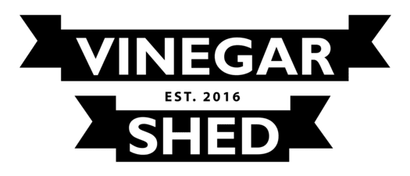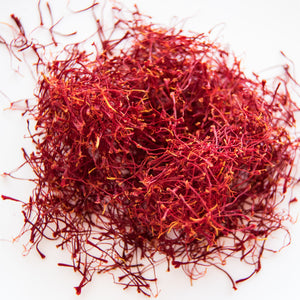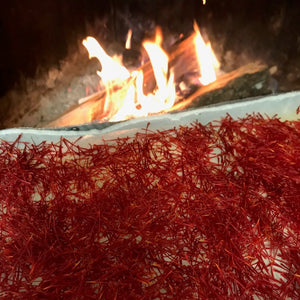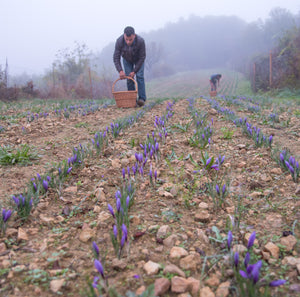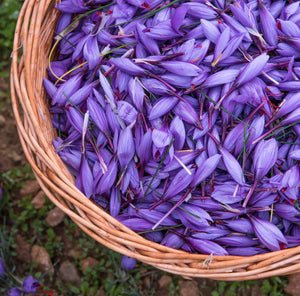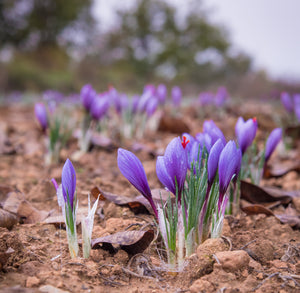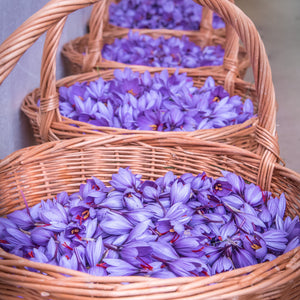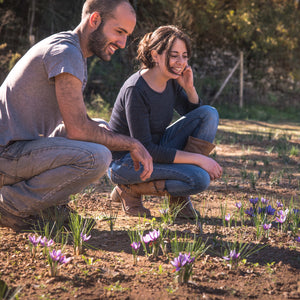- Home
- Shop
- About
- Recipes
- Videos
- Press
- Stockists
- Trade Enquiries
- Contact
- Log in
-
GBP £
Safrà del Montsec - Organic Saffron 1g
£22.00
– Sold OutIn a nutshell: Finest-quality, organically grown Catalan saffron, hand-picked from the early-morning fields, gently dried over an oak fire for maximum flavour.
Great Taste 2019 2-star award-winner
Back in the Middle Ages, Catalonia’s hot, dry summers and cold winters helped to make it the centre of the world’s saffron production. Now, thanks to the vision of one young farming couple, this ancient tradition is being revived.
For the past 5 years, the husband-and-wife team of Jaume Casado Carulla and Magda Plazas Figueroa have been producing coupe-grade saffron – AKA, the very best quality – from their Masia farmhouse in the Pyrenean foothills.
The delicate crocuses are hand-picked in October, when the early-morning mists ensure that the flowers will still be closed – an essential factor when it comes to maintaining the quality of their pistils, the crocus’s female reproductive organs that will become saffron.
After harvest, the flowers are unbladed – the painstaking process of individually separating by hand each vibrant-red pistil from its parent bloom. These pistils are then dried in front of a holm-oak fire, which imbues the saffron with its subtle, smoky aroma.
The result of this attention to detail is a premium saffron with a vivid fragrance and intense depth of flavour.
Given its extremely high quality and flavour, less of the pistils are needed for cooking purposes which more than justifies the price.
Until recently, it’s been the preserve of top chefs – now we are delighted to offer it to you.
How to use:
- For best results, infuse the saffron in hot water, broth or other liquid. Use the infused spice to bring a depth of smoky flavour to rice-based dishes such as paella, risotto alla Milanese and Persian tahdig-crusted pilaffs.
- Add it to zarzuela de Mariscos, the hearty Catalan seafood stew, enriched with ground almonds.
- Add a few pistils to the water when boiling spuds for yellow Spanish-style saffron potatoes (don’t discard the water – use it in a fish or chicken soup).
- Infuse the saffron in milk to use in a crema Catalana or in Indian desserts. Alternatively, add a few strands to the liqueur when poaching pears.
Details: Available in ½g, 1g, 2g and 4g stoppered vials.
About Safrà del Montsec
It’s 6 o’clock on an October morning, the mist hangs low over the valleys of the Montsec hills, and there’s a nip of autumn in the air.
Not many people are at work at this hour – but the crocus pickers of Safrà del Montsec are hard at it because this time of day, and these precise conditions, are just what’s needed to produce the world’s very best saffron.
“It’s important for us to pick the flowers when they are still closed to ensure that the properties of our saffron are not altered by the pollination of the bees, who also intend to enjoy the harvest,” says Jaume Casado Carulla.
Together with his wife, Magda Plazas Figueroa, Jaume has been farming saffron crocuses for the past 5 years, since the couple bought an old stone masia (farmhouse) and relocated from Barcelona to revive the ancient craft of saffron making, which has been pursued in this part of Catalonia since the Middle Ages.
It’s not surprising to learn that saffron is the world’s most highly prized spice when you see what goes into it when it’s produced properly, the way it is at Safrà del Montsec.
After its early-morning harvest, the saffron crocuses are borne in wicker baskets to the processing room. Here, a team of dedicated workers sets about the fiddly process of unblading – that is, removing the bright-red pistil from each and every flower.
As if that weren’t enough, they then cut each one to nip off the white bottom third, which wouldn’t bring anything to the saffron’s flavour but would, of course, bulk out its weight.
After this, the pistils are gently heated in front of a fire of oak or holm-oak logs, which dries them out into deep-red, smoky saffron threads.
“With our dehydration process, we want to revive the tradition of yesteryear, when the heat produced by the embers of the kitchen fireplace would be used,” says Jaume.
These time-honoured production methods have a direct impact upon the quality of the saffron, which is independently classified as coupe category 1 – that is, the highest grade that can be awarded to saffron.
It’s why it’s in such demand from top chefs in Spain and throughout Europe. And it’s why we’re thrilled to be introducing it to you.
Collections: Great Taste Award Winners , Organic , Perfect Gifts , Saffron
You may also like
News & Updates
Sign up to get the latest on sales, new releases and more…
HELPFUL LINKS
VISIT THE EALING GROCER
Our new neighbourhood food store is now open for all Vinegar Shed products plus everyday staples, fruit & veg, cheese & charcuterie, provisions, kitchenalia & food to go.
18 St. Mary’s Road, Ealing, London, W5 5ES. Tel: 0208 566 0632
Opening times:
Tuesday-Saturday 9AM to 5PM
Sunday 9AM to 3PM
© 2025 Vinegar Shed. | Photography by David Loftus | Powered by Shopify
